The first patient in the world was successfully cured with Mesenchymal Stem Cells for Multiple Sclerosis
In 2004, Louise was playing a Canadian Women’s Tour event in Nova Scotia, Canada when she felt some tingling in her left thumb and one finger. She felt her strength diminishing in her arm and wondered what was happening. Still, she was mostly fine until January 2007, when she started getting progressively weaker and having balance and endurance problems.
In 2007, Louise Zilstra was diagnosed with rapidly-progressive multiple sclerosis.
By the start of this year, she was not just unable to play an 18-hole golf game, but she could barely walk 50 yards.
Louise consulted her doctor. Mark Freedman, an MS specialist from Ottawa, Canada. He recommended a completely new treatment for her with Israeli professor Shimon Slavin. The treatment consisted of using her own (auto) mesenchymal stromal cells, taken from her own bone marrow, cultured in the laboratory and then injected intrathecally into the spinal cord.
“Her course is a primary progressive one, and right now we have no sure treatments for primary progressive disease,” neurologist Dr. Mark Freedman, an MS specialist at Ottawa Hospital, told CTV News.
Primary progressive MS accounts for between 10 and 15 percent of cases and often does not follow a predictable disease pattern, Freedman said.
Freedman told Zylstra that within two years she would likely end up in a wheelchair.
“It was a disaster,” Zylstra told CTV News. “When you think, I might not play golf again and that’s what you do, it’s like, what am I going to do?”
Eight months after traveling to Israel for the treatment, Louise is back on the golf course.
“It’s night and day,” Zylstra said. “It’s a complete 180 from where I was.”
Given the progressive nature of Zylstra’s MS, such a recovery would have been highly unlikely without the treatment, Freedman said.
“She’s recovered substantial function very quickly,” Freedman said. “She’s out golfing, and out-golfing most people, which is quite incredible.”
Larger, more objective studies must be done to accurately measure the treatment’s effectiveness, Slavin said.
The team must also study mesenchymal cells further, to better understand the action they have on preventing the immune system from attacking nerve cells.
The findings also offer hope that the treatment may help patients with ALS and spinal cord injuries, and even to rejuvenate aging or damaged organs.
“The secret is to do the treatment of choice in the early stages of the disease before irreversible changes occur,” Slavin said. Researchers are also testing the technique on a number of other neurodegenerative diseases.
As a result of the treatment, Louise’s condition has completely returned to normal!

